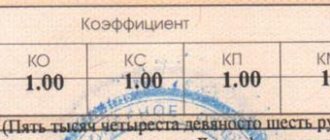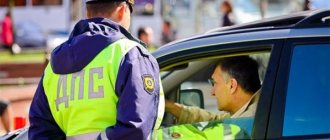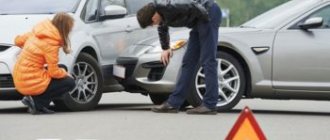Types of accidents and their causes
Classification of road traffic accidents is necessary because:
- is an element of determining the cause of an accident;
- allows you to clearly indicate the degree of guilt of the participant;
- allows you to limit the extent of material damage;
- is the basis for classifying the degree of guilt (administrative, criminal) depending on the harm caused to the victim.
There are both general reasons for road accidents, such as poor driving, failure to keep a distance, talking on the phone while driving, and specific reasons for certain road accidents.
That is why, in some cases, the most probable cause is already clear from the classification itself, which can serve for static analysis and planning of measures to prevent this type of accident in a certain area, where they occur much more often than on average.
Classification to indicate the degree of fault is important for insurance companies when resolving a dispute in court, therefore an incorrectly classified accident may lead to an incorrect court decision or denial of insurance compensation.
Correct classification allows the insurer to limit the insurance compensation to the amount specified in the contract specifically for this insured event.
Significant damage to the health or death of the victim may become the basis for initiating a criminal case.
Road accidents can be classified:
- according to the objectivity of the reason for the occurrence;
- for his reason;
- according to the method of occurrence;
- the severity of the consequences;
- on preventability.
The silver car violated clause 8.8 of the traffic rules
Here's what the Rules say about this: 8.8. When turning left or making a U-turn outside an intersection, the driver of a trackless vehicle must give way to oncoming vehicles and a tram in the same direction.
If, when turning outside an intersection, the width of the roadway is not sufficient to perform the maneuver from the extreme left position, it is allowed to be made from the right edge of the roadway (from the right shoulder). In this case, the driver must give way to passing and oncoming vehicles.
Classification according to the objectivity of the factors of occurrence
All road accidents due to (factors) of occurrence can be divided into having:
- objective reason for the occurrence : quality of the road surface, weather conditions (poor visibility, ice, strong side winds), lack of warning road signs;
- the subjective reason for the occurrence is everything that concerns exclusively the personal decisions of the participants in the accident.
When considering the degree of guilt of the participants, the existence of objective reasons for the occurrence of an accident is a mitigating circumstance.
Why does the number of accidents involving two-wheelers traditionally increase in April?
The opening of the motorcycle season has sharply increased the number of accidents on Russian roads. In April, the traffic police counted 258 accidents involving motorcyclists. This is six times more than it was in March, writes Kommersant. After such incidents, 27 people died on the roads and 262 were injured. Inspectors identified the most accidents involving two-wheeled vehicles in the Central Federal District. There were 29 road accidents involving motorcycles in Moscow and the Moscow region. Why have accident rates increased so much?
Chairman of the Russian Motorists Movement Viktor Pokhmelkin is convinced that the recklessness of motorcyclists is primarily to blame: “Motorists lose the habit of motorcycles over the winter, and motorcyclists drive as if everyone can see them, and do not always follow the rules and speed limits. I don't like it when they go supersonic. And driving between the rows is their advantage. It is clear that an experienced motorist, of course, should always count on the appearance of a motorcycle. At the same time, the rules should indicate how a motorcyclist should ride between the rows and how to let them pass.”
What devices will record traffic violations?
The capital's Traffic Management Center (TCOC), in turn, called the growing accident rate involving two-wheeled vehicles an annual and natural process that occurs with the onset of heat.
Many motorcyclists actually lose their driving skills in the cold season, however, difficult road conditions in the spring also affect accident rates, says Oleg Breiter, president of the Z-brothers motorcycle club: “A motorcycle is not an all-season mode of transport. Most motorcyclists stay off the roads in winter.
The large increase in accidents in April is due, among other things, to inexperience. In addition, the asphalt has not yet warmed up, so the clutch, the so-called “grip” in slang, is not yet confident enough.
In winter, our roads are sprinkled with chemical mixtures and sand. It all remains on the asphalt. Therefore, experienced motorcyclists drive very carefully in April, trying not to make sudden maneuvers, lane changes, acceleration and braking.”
Why driving schools don't want new exams
According to the traffic police, in April the number of accidents involving electric scooters and unicycles increased five times compared to March. Accidents involving injured cyclists increased almost 4.5 times. The number of accidents with two-wheeled vehicles is growing not only because of the notorious human factor, Natalya Agre, a member of the government commission on road safety, is convinced: “First of all, we need to talk about the frequency of use of these types of vehicles. It is clear that if there is active stimulation, as in large regions, where they are pushing to use means of individual mobility, two-wheeled transport. Naturally, this also affects the number of accidents. The second point is that the driver is often distracted by gadgets when driving. Every time he closes his eyes at a speed of 60 km/h, he travels 60 m in two or three seconds. Because of this, the two-wheeled vehicle, which is constantly changing lanes, ends up under the wheels.”
The data center and the experts interviewed by Kommersant FM also attributed the growing accident rate to legislative reasons. Electric scooters and unicycles still do not have a clear legal status; their users today are considered equal to pedestrians. Back in 2020, the Ministry of Transport proposed large-scale amendments to the traffic rules to resolve this issue. However, the authorities still cannot agree on this project.
Classification by causes of accidents
All accidents can be classified into:
- common to all types of accidents;
- specific for a certain type of accident.
The reasons common to all types of accidents are:
- being in an inadequate state (under the influence of psychoactive substances, tranquilizers, sick, tired);
- over speed;
- diverting the attention of the person driving the vehicle to foreign objects: cell phone, tablet, etc.
Specific causes are the reasons that in most cases lead to road accidents of a certain mechanism of occurrence.
For example, failure to allow a vehicle with the right of way to pass often leads to lateral or tangential collisions, technical malfunction of the brakes leads to rear collisions, driving into the oncoming lane leads to frontal collisions, etc.
Some types of reasons, for example, being intoxicated, make a person guilty a priori , without further consideration of the circumstances of the accident.
Main causes of road accidents
In the vast majority of cases, accidents occur due to intentional or accidental violation of traffic rules. Both from drivers and from pedestrians. This is the main cause of accidents. We are talking about a wide variety of violations - failure to comply with the speed limit, ignoring the rules for driving or crossing intersections, driving into the oncoming lane or driving through a prohibiting traffic light, failure to maintain distance, violation of the rules for crossing a railway crossing, not wearing a seat belt.
Often, traffic violations are made unintentionally or provoked by other factors. Causes of road accidents:
- Drinking alcohol while driving. According to global statistics, about 35% of all accidents occur with the participation of drunk vehicle drivers. And we are talking only about officially registered cases; often an examination is simply not ordered, because intoxication does not manifest itself outwardly. Alcohol significantly reduces the speed of reaction and maneuvers, and also leads to drowsiness (especially in combination with fatigue);
- Communication while driving. Nowadays there are a huge number of electronic gadgets that drivers can use while driving. And we’re not even talking about communicating on a mobile phone, but about sending emails, browsing social networks, using Viber, WatsAPP and other programs. All this significantly reduces the driver’s attentiveness and leads to a slower reaction to danger. Thus, talking on a mobile phone reduces reaction speed by 15-20%, and typing electronic messages reduces attentiveness by 6 or even 10 times;
- Poor technical condition of the car. The technical condition of a vehicle does not often cause accidents, but it can lead to very serious consequences, including death. For example, due to an incorrectly configured brake system of the car or a non-deployed airbag;
- Poor quality of road surface. This also includes malfunctioning traffic lights, incorrect placement of road signs, and ignoring the rules for applying road markings. The problem with roads is further aggravated by the fact that road services are extremely rarely held accountable for accidents caused by potholes and holes on dangerous sections of the road;
- Incorrect behavior of pedestrians on the road. This mainly concerns jaywalking or crossing an intersection when the traffic light is red. Most often, collisions with pedestrians who do not comply with traffic rules are made in the dark. Therefore, when walking in the evenings and at night, you should take care of the presence of reflective elements on your clothes;
- Bad weather conditions. When driving in fog, heavy rain, snow or ice, the viewing range is significantly reduced, the adhesion of the tires to the road surface is reduced, and the braking distance of the car is noticeably increased. These are just some of the adverse weather factors that are a common cause of road accidents.
Classification by method of occurrence
Depending on the method or mechanism of occurrence, road accidents are of the following types.
Collision
Collisions can be of the following types:
- windshield;
- rear;
- lateral;
- tangent.
A head-on collision is a collision between vehicles traveling towards each other.
This is the most dangerous type of accident, since the energy of vehicles moving towards is summed up. This type of accident often ends in death for those involved. It is most often found on intercity highways without physical separation of lanes when overtaking and entering the oncoming lane. A rear-end collision is a collision between vehicles traveling in the same direction but at different speeds. May cause damage to multiple vehicles. The main specific reasons are failure to maintain distance, driver distraction, technical malfunctions of the brake system, and lack of studded tires in winter. Often this is also caused by driver distraction and speeding. Usually occurs on busy highways in bad weather conditions (ice, rain). Rarely leads to serious consequences.
A side collision is a collision between vehicles moving along a perpendicular path.
Most often it occurs when a vehicle exits from a secondary side road onto the main road at unregulated intersections and forks. It usually occurs within the city limits. The reason is most often the inattention of the driver leaving a secondary road with limited visibility when driving away from foreign objects (advertising billboards, trees, etc.). The second reason, and even more often, an accompanying one, may be speeding by a driver driving on the main road. A tangential collision is a collision between vehicles moving in the same direction. Occurs at uncontrolled intersections and in roundabouts when traffic rules are violated - failure to give the right of way to a vehicle according to traffic rules, or inattention when changing lanes. As a rule, it is not accompanied by serious damage.
Rollover
A rollover occurs when the speed is greatly exceeded under circumstances that are not conducive to stable movement: a sharp turn with an incline, a broken or broken wheel, a slippery road surface. It can also occur when abruptly exiting a side skid.
It is a very dangerous accident for participants, as it can lead not only to mechanical damage to the car, but also to fire as a result of fuel detonation.
Hitting a stationary vehicle
A collision with a stationary vehicle occurs within the city due to the inattention of an active participant, or due to improper parking of a stationary vehicle. Can have a wide variety of consequences depending on the speed of the moving participant.
Colliding with a pedestrian
A collision between a car and a person moving along the roadway or sidewalk is classified as a pedestrian collision. An accident in which a collision with a car in motion was initiated by a pedestrian is also interpreted. This can happen due to driver inattention, speeding, limited visibility and bad weather conditions, as well as when a pedestrian does not comply with traffic rules. From a legal point of view, the driver bears greater responsibility for such an accident as a person who has responsibility for a high-risk vehicle, a car. Therefore, if a traffic violation leads to an accident of this type, the driver will face administrative liability with a fine.
In the event of the death of a pedestrian, criminal liability arises.
Hitting a cyclist
In terms of the interpretation of guilt and legal consequences, a collision with a cyclist is similar to a collision with a pedestrian. The only difference is that from the point of view of traffic rules, a bicycle is also a vehicle and the rules for riding a bicycle differ from the rules for moving a pedestrian. A common example is a collision with a cyclist when the cyclist crosses the roadway at a pedestrian crossing while driving a bicycle, which is prohibited by traffic rules.
A cyclist's state of intoxication makes him guilty of an accident, just like driving a car.
Hitting a horse-drawn vehicle
A horse-drawn vehicle collision is a collision between a vehicle and a cart containing draft animals. This type of accident is more common in rural areas. The reason may be inattention and violation of traffic rules by the driver, insufficient interaction between the experience of the driver and the draft animals of the horse-drawn vehicle.
Hitting an animal
Hitting an animal is treated as an accident, even if the driver of the vehicle did not suffer damage, since domestic animals, according to law, are the property of their owners, and wild animals are the property of the state (Civil Code, Art. 137, Law on Animal World, Art. 4 ).
Therefore, according to the law, an accident involving animals also requires registration and compensation for damage to the injured party under compulsory motor liability insurance.
Passenger fall
According to statistics, passenger falls in public transport account for about 40% of cases in which public transport drivers violated traffic rules. Most often they occur during emergency braking. In some cases of falls, the fault of passengers who violate the rules of travel on public transport can be traced. It should be noted that if a passenger falling on a bus is interpreted as an accident, then the continuation of the bus movement is considered as leaving the scene of an accident, with all legal consequences for the driver.
Passengers falling out of a car are very dangerous, although they are rare.
Other types of accidents
Other types of accidents according to the method of occurrence include all incidents that do not fall into the described classification - for example, causing damage to people who are not participants in the traffic in a collision with a residential building, the fall of an unsecured load from a cargo vehicle, derailment of a tram, etc.
In such cases, the responsible party and the reasons for what happened are quite obvious - this is the driver of the vehicle and his behavior, which led to damage to passive participants.
Types of traffic accidents
In theory and practice, there are several options for qualifying an accident. Incidents are classified according to the severity of the consequences:
- with a fatal outcome, taking into account the previously introduced concept of a person killed as a result of an accident;
- with bodily injuries;
- with material damage.
According to the severity of the consequences, road accidents are distinguished that entailed:
- material damage;
- minor bodily injury - short-term health disorder or minor permanent loss of general ability to work (Note 1 to Article 12.24 of the Code of Administrative Offenses of the Russian Federation);
- bodily injury of moderate harm - a long-term health disorder that is not life-threatening or a significant permanent loss of general ability to work by less than one third (note 2 to Article 12.24 of the Code of Administrative Offenses of the Russian Federation);
- grievous bodily injury - life-threatening harm, loss of vision, speech, hearing or any organ or loss of organ functions, termination of pregnancy, mental disorder, drug addiction or substance abuse, permanent disfigurement of the face, significant permanent loss of general working capacity of at least one third, complete loss of professional ability to work (Resolution of the Government of the Russian Federation of August 17, 2007 No. 522);
- death of the victim;
- especially grave consequences (death of 4 or more people, injury of 15 or more people).
The severity of bodily injuries is determined by a medical examination.
Based on the nature of the incident, they are distinguished (Appendix G to ODM 218.6.015–2015):
- collision of vehicles with each other or with a train;
- rollover - loss of stability not due to a collision or run-over, driving off the road (for example, with a critical slope of the road, as a result of a gust of wind, etc.);
- hitting a stationary vehicle;
- hitting an obstacle (any stationary object other than a vehicle);
- collision with a pedestrian, including when the pedestrian collided with a car;
- hitting a cyclist, including when the cyclist collided with a car;
- collision with horse-drawn transport (both animals and the device driven by it), including when such transport collided with a car;
- a passenger falls while moving (for example, on a bus);
A passenger falling on a bus is also an accident - other road accidents: collision with animals other than horse-drawn vehicles;
- leaving the road;
- falling load;
- throwing away an object;
- hitting a person who is not a pedestrian (traffic police officer, road worker, etc.).
Somewhat conventionally, road accidents can be divided into recordable and non-recordable. The convention is that, according to clause 3 of the Rules for Recording Road Accidents, all incidents are subject to recording, and the responsibility rests not only with the Department of Internal Affairs, but also directly with the owners of vehicles - legal entities, road authorities and road owners. But state statistical reporting includes information only about road accidents that resulted in death and/or injury of people (clause 5 of the Rules) with some exceptions (if the accident occurred as a result of a suicide attempt, an attack on life and health, during car competitions and some others).
State statistical reporting only takes into account road accidents that resulted in deaths or injuries.
It is not clear how this requirement is combined with that provided for in Art. 11.1 Federal Law dated April 25, 2002 No. 40-FZ “On Compulsory Motor Liability Insurance” (MTPL) gives the right to register an accident without the participation of the traffic police. The responsibilities of insurers do not include transmitting information to the police about incidents that have become known to them and documented under the so-called European protocol. It is obvious that a huge number of road accidents remain unknown to the internal affairs bodies and are not taken into account in the mandatory analysis of the causes and conditions of incidents and the development of measures to prevent them. This situation is another significant disadvantage of the European protocol, along with the fact that the independent registration of road accidents by their participants allows the culprit to avoid liability for violating traffic rules.
In the literature, the concept of a “non-contact accident” is found, which means an event that meets all the signs of an accident, but in the absence of interaction between the cars of the participants, and the consequences occur as a result of hitting an object or colliding with another car. A fairly common occurrence is that the driver “cuts off” or brakes sharply, thereby creating an emergency situation. If an accident occurs as a result, the question arises about the involvement of such a driver in the incident. Cases of holding people accountable and imposing obligations to compensate for damage caused as a result of an event provoked by such actions are rare.
The prevalence of the phenomenon led to the introduction in May 2021 of the concept of dangerous driving in clause 2.7 of the Traffic Regulations and the establishment of a ban for drivers to perform a number of actions (repeated lane changes, violations of distances and intervals, etc.). With the innovation, a legal basis arose for presenting property claims against “dashing” drivers, but the difficulty lies in the fact that such road users prefer not to pay attention to the accident that has occurred and calmly continue driving. It is not always possible to prove the involvement of a specific person in causing harm, even if it is possible to record the license plate number of the car and the circumstances of the incident.
Only data recorded by the traffic police are included in the statistics.
Another specific type of incident is a hidden accident. The person who committed a traffic violation and committed a traffic accident flees the scene. His involvement can be proven by conducting a trace examination, if the car number is known. Here the question also arises about the involvement of a specific driver if several people are allowed to drive the car. Theoretically, situations are possible when the victim disappears from the scene.









